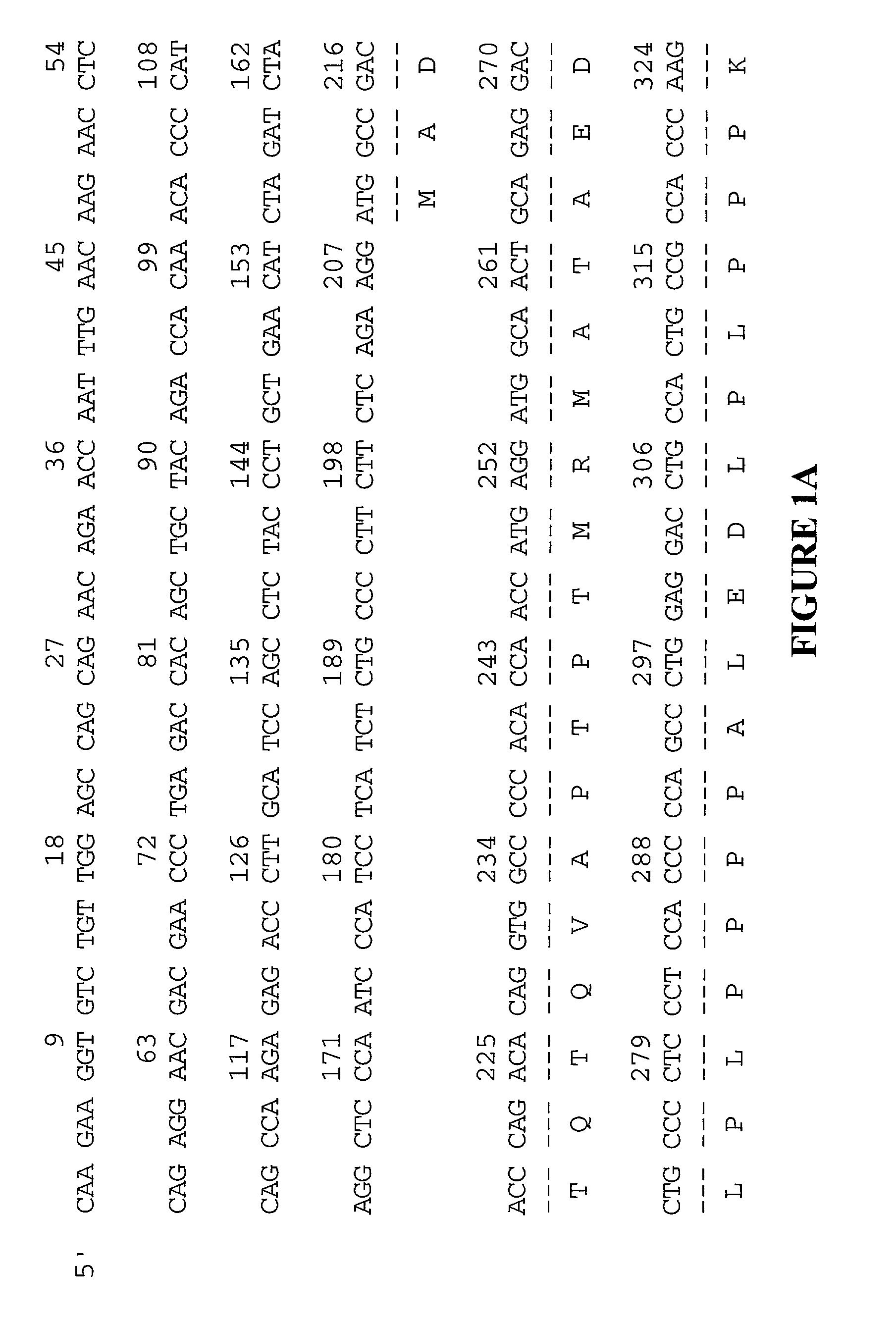[0071] Any one of a multitude of cDNAs encoding XRP may be cloned into a vector and used to express the
protein, or portions thereof, in host cells. The
nucleic acid sequence can be engineered by such methods as
DNA shuffling (U.S. Pat. No. 5,830,721) and site-
directed mutagenesis to create new restriction sites, alter
glycosylation patterns, change codon preference to increase expression in a particular host, produce splice variants, extend half-life, and the like. The
expression vector may contain transcriptional and translational control elements (promoters, enhancers, specific
initiation signals, and polyadenylated 3' sequence) from various sources which have been selected for their efficiency in a particular host. The vector, cDNA, and regulatory elements are combined using
in vitro recombinant DNA techniques, synthetic techniques, and / or
in vivo genetic recombination techniques well known in the art and described in Sambrook (supra, ch. 4, 8, 16 and 17).
[0081] Various hosts including goats, rabbits, rats, mice, humans, and others may be immunized by injection with XRP or any portion thereof. Adjuvants such as Freund's, mineral gels, and surface active substances such as lysolecithin, pluronic polyols, polyanions, peptides, oil emulsions,
keyhole limpet hemacyanin (KLH), and
dinitrophenol may be used to increase immunological response. The
oligopeptide,
peptide, or portion of
protein used to induce antibodies should consist of at least about five amino acids, more preferably ten amino acids, which are identical to a portion of the natural protein. Oligopeptides may be fused with proteins such as KLH in order to produce antibodies to the chimeric molecule.
[0083] Alternatively, techniques described for the production of
single chain antibodies may be adapted, using methods known in the art, to produce
epitope specific
single chain antibodies.
Antibody fragments which contain specific binding sites for epitopes of the protein may also be generated. For example, such fragments include, but are not limited to, F(ab')2 fragments produced by
pepsin digestion of the
antibody molecule and
Fab fragments generated by reducing the disulfide bridges of the F(ab')2 fragments. Alternatively, Fab expression libraries may be constructed to allow rapid and easy identification of
monoclonal Fab fragments with the desired specificity. (See, e.g., Huse et al. (1989) Science 246:1275-1281.)
[0102] Complementary nucleic acids and ribozymes of the invention may be prepared via
recombinant expression,
in vitro or
in vivo, or using
solid phase
phosphoramidite chemical synthesis. In addition,
RNA molecules may be modified to increase
intracellular stability and half-life by addition of flanking sequences at the 5' and / or 3' ends of the molecule or by the use of phosphorothioate or 2' O-methyl rather than
phosphodiesterase linkages within the backbone of the molecule. Modification is inherent in the production of PNAs and can be extended to other
nucleic acid molecules. Either the inclusion of nontraditional bases such as
inosine, queosine, and wybutosine, and or the modification of adenine,
cytidine,
guanine,
thymine, and
uridine with acetyl-, methyl-,
thio-groups renders the molecule less available to endogenous endonucleases.
[0114] Animal models may be used as bioassays where they exhibit a phenotypic response similar to that of humans and where
exposure conditions are relevant to human exposures. Mammals are the most common models, and most
infectious agent,
cancer,
drug, and
toxicity studies are performed on rodents such as rats or mice because of low cost, availability, lifespan, reproductive potential, and abundant reference literature. Inbred and outbred
rodent strains provide a convenient model for investigation of the physiological consequences of under- or over-expression of genes of interest and for the development of methods for diagnosis and treatment of diseases. A
mammal inbred to over-express a particular
gene (for example, secreted in milk) may also serve as a convenient source of the protein expressed by that
gene.
 Login to View More
Login to View More 


